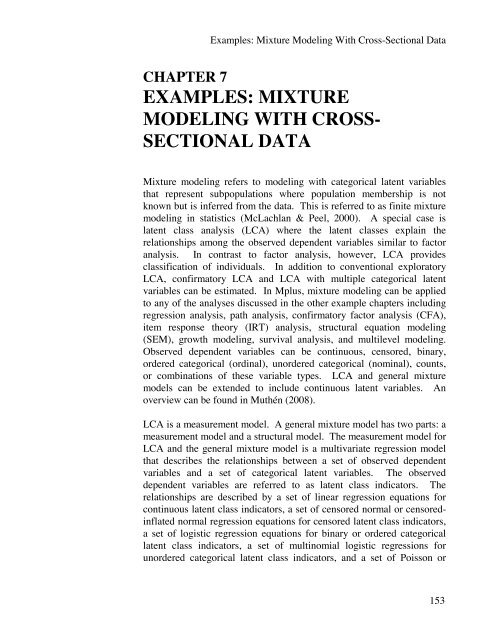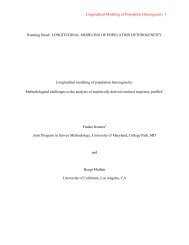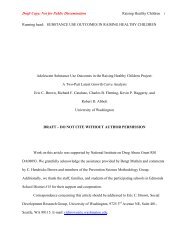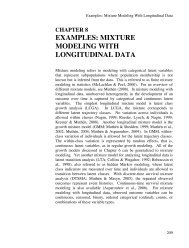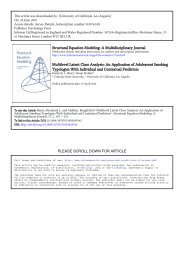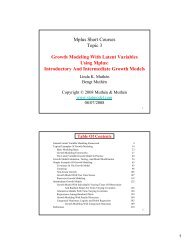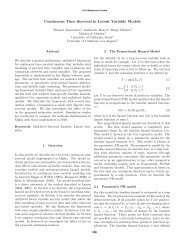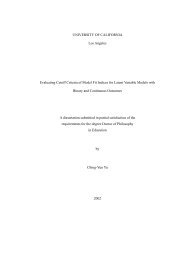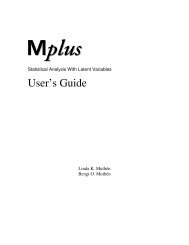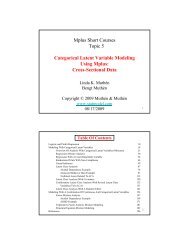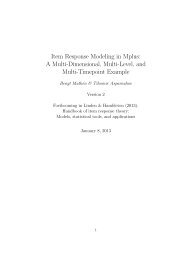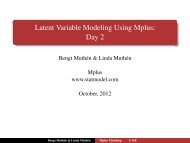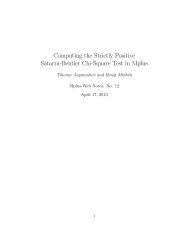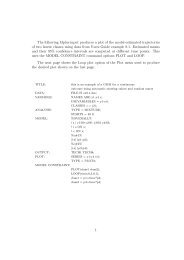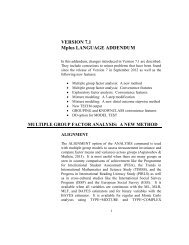EXAMPLES: MIXTURE MODELING WITH CROSS ... - Mplus
EXAMPLES: MIXTURE MODELING WITH CROSS ... - Mplus
EXAMPLES: MIXTURE MODELING WITH CROSS ... - Mplus
You also want an ePaper? Increase the reach of your titles
YUMPU automatically turns print PDFs into web optimized ePapers that Google loves.
Examples: Mixture Modeling With Cross-Sectional Data<br />
CHAPTER 7<br />
<strong>EXAMPLES</strong>: <strong>MIXTURE</strong><br />
<strong>MODELING</strong> <strong>WITH</strong> <strong>CROSS</strong>-<br />
SECTIONAL DATA<br />
Mixture modeling refers to modeling with categorical latent variables<br />
that represent subpopulations where population membership is not<br />
known but is inferred from the data. This is referred to as finite mixture<br />
modeling in statistics (McLachlan & Peel, 2000). A special case is<br />
latent class analysis (LCA) where the latent classes explain the<br />
relationships among the observed dependent variables similar to factor<br />
analysis. In contrast to factor analysis, however, LCA provides<br />
classification of individuals. In addition to conventional exploratory<br />
LCA, confirmatory LCA and LCA with multiple categorical latent<br />
variables can be estimated. In <strong>Mplus</strong>, mixture modeling can be applied<br />
to any of the analyses discussed in the other example chapters including<br />
regression analysis, path analysis, confirmatory factor analysis (CFA),<br />
item response theory (IRT) analysis, structural equation modeling<br />
(SEM), growth modeling, survival analysis, and multilevel modeling.<br />
Observed dependent variables can be continuous, censored, binary,<br />
ordered categorical (ordinal), unordered categorical (nominal), counts,<br />
or combinations of these variable types. LCA and general mixture<br />
models can be extended to include continuous latent variables. An<br />
overview can be found in Muthén (2008).<br />
LCA is a measurement model. A general mixture model has two parts: a<br />
measurement model and a structural model. The measurement model for<br />
LCA and the general mixture model is a multivariate regression model<br />
that describes the relationships between a set of observed dependent<br />
variables and a set of categorical latent variables. The observed<br />
dependent variables are referred to as latent class indicators. The<br />
relationships are described by a set of linear regression equations for<br />
continuous latent class indicators, a set of censored normal or censoredinflated<br />
normal regression equations for censored latent class indicators,<br />
a set of logistic regression equations for binary or ordered categorical<br />
latent class indicators, a set of multinomial logistic regressions for<br />
unordered categorical latent class indicators, and a set of Poisson or<br />
153
CHAPTER 7<br />
zero-inflated Poisson regression equations for count latent class<br />
indicators.<br />
The structural model describes three types of relationships in one set of<br />
multivariate regression equations: the relationships among the<br />
categorical latent variables, the relationships among observed variables,<br />
and the relationships between the categorical latent variables and<br />
observed variables that are not latent class indicators. These<br />
relationships are described by a set of multinomial logistic regression<br />
equations for the categorical latent dependent variables and unordered<br />
observed dependent variables, a set of linear regression equations for<br />
continuous observed dependent variables, a set of censored normal or<br />
censored normal regression equations for censored-inflated observed<br />
dependent variables, a set of logistic regression equations for binary or<br />
ordered categorical observed dependent variables, and a set of Poisson<br />
or zero-inflated Poisson regression equations for count observed<br />
dependent variables. For logistic regression, ordered categorical<br />
variables are modeled using the proportional odds specification.<br />
Maximum likelihood estimation is used.<br />
The general mixture model can be extended to include continuous latent<br />
variables. The measurement and structural models for continuous latent<br />
variables are described in Chapter 5. In the extended general mixture<br />
model, relationships between categorical and continuous latent variables<br />
are allowed. These relationships are described by a set of multinomial<br />
logistic regression equations for the categorical latent dependent<br />
variables and a set of linear regression equations for the continuous<br />
latent dependent variables.<br />
In mixture modeling, some starting values may result in local solutions<br />
that do not represent the global maximum of the likelihood. To avoid<br />
this, different sets of starting values are automatically produced and the<br />
solution with the best likelihood is reported.<br />
All cross-sectional mixture models can be estimated using the following<br />
special features:<br />
• Single or multiple group analysis<br />
• Missing data<br />
• Complex survey data<br />
154
Examples: Mixture Modeling With Cross-Sectional Data<br />
• Latent variable interactions and non-linear factor analysis using<br />
maximum likelihood<br />
• Random slopes<br />
• Linear and non-linear parameter constraints<br />
• Indirect effects including specific paths<br />
• Maximum likelihood estimation for all outcome types<br />
• Bootstrap standard errors and confidence intervals<br />
• Wald chi-square test of parameter equalities<br />
• Test of equality of means across latent classes using posterior<br />
probability-based multiple imputations<br />
For TYPE=<strong>MIXTURE</strong>, multiple group analysis is specified by using the<br />
KNOWNCLASS option of the VARIABLE command. The default is to<br />
estimate the model under missing data theory using all available data.<br />
The LISTWISE option of the DATA command can be used to delete all<br />
observations from the analysis that have missing values on one or more<br />
of the analysis variables. Corrections to the standard errors and chisquare<br />
test of model fit that take into account stratification, nonindependence<br />
of observations, and unequal probability of selection are<br />
obtained by using the TYPE=COMPLEX option of the ANALYSIS<br />
command in conjunction with the STRATIFICATION, CLUSTER, and<br />
WEIGHT options of the VARIABLE command. The<br />
SUBPOPULATION option is used to select observations for an analysis<br />
when a subpopulation (domain) is analyzed. Latent variable interactions<br />
are specified by using the | symbol of the MODEL command in<br />
conjunction with the X<strong>WITH</strong> option of the MODEL command. Random<br />
slopes are specified by using the | symbol of the MODEL command in<br />
conjunction with the ON option of the MODEL command. Linear and<br />
non-linear parameter constraints are specified by using the MODEL<br />
CONSTRAINT command. Indirect effects are specified by using the<br />
MODEL INDIRECT command. Maximum likelihood estimation is<br />
specified by using the ESTIMATOR option of the ANALYSIS<br />
command. Bootstrap standard errors are obtained by using the<br />
BOOTSTRAP option of the ANALYSIS command. Bootstrap<br />
confidence intervals are obtained by using the BOOTSTRAP option of<br />
the ANALYSIS command in conjunction with the CINTERVAL option<br />
of the OUTPUT command. The MODEL TEST command is used to test<br />
linear restrictions on the parameters in the MODEL and MODEL<br />
CONSTRAINT commands using the Wald chi-square test. The<br />
AUXILIARY option is used to test the equality of means across latent<br />
classes using posterior probability-based multiple imputations.<br />
155
CHAPTER 7<br />
Graphical displays of observed data and analysis results can be obtained<br />
using the PLOT command in conjunction with a post-processing<br />
graphics module. The PLOT command provides histograms,<br />
scatterplots, plots of individual observed and estimated values, plots of<br />
sample and estimated means and proportions/probabilities, and plots of<br />
estimated probabilities for a categorical latent variable as a function of<br />
its covariates. These are available for the total sample, by group, by<br />
class, and adjusted for covariates. The PLOT command includes<br />
a display showing a set of descriptive statistics for each variable. The<br />
graphical displays can be edited and exported as a DIB, EMF, or JPEG<br />
file. In addition, the data for each graphical display can be saved in an<br />
external file for use by another graphics program.<br />
Following is the set of examples included in this chapter.<br />
• 7.1: Mixture regression analysis for a continuous dependent<br />
variable using automatic starting values with random starts<br />
• 7.2: Mixture regression analysis for a count variable using a zeroinflated<br />
Poisson model using automatic starting values with random<br />
starts<br />
• 7.3: LCA with binary latent class indicators using automatic starting<br />
values with random starts<br />
• 7.4: LCA with binary latent class indicators using user-specified<br />
starting values without random starts<br />
• 7.5: LCA with binary latent class indicators using user-specified<br />
starting values with random starts<br />
• 7.6: LCA with three-category latent class indicators using userspecified<br />
starting values without random starts<br />
• 7.7: LCA with unordered categorical latent class indicators using<br />
automatic starting values with random starts<br />
• 7.8: LCA with unordered categorical latent class indicators using<br />
user-specified starting values with random starts<br />
• 7.9: LCA with continuous latent class indicators using automatic<br />
starting values with random starts<br />
• 7.10: LCA with continuous latent class indicators using userspecified<br />
starting values without random starts<br />
• 7.11: LCA with binary, censored, unordered, and count latent class<br />
indicators using user-specified starting values without random starts<br />
• 7.12: LCA with binary latent class indicators using automatic<br />
starting values with random starts with a covariate and a direct effect<br />
156
Examples: Mixture Modeling With Cross-Sectional Data<br />
• 7.13: Confirmatory LCA with binary latent class indicators and<br />
parameter constraints<br />
• 7.14: Confirmatory LCA with two categorical latent variables<br />
• 7.15: Loglinear model for a three-way table with conditional<br />
independence between the first two variables<br />
• 7.16: LCA with partial conditional independence*<br />
• 7.17: Mixture CFA modeling<br />
• 7.18: LCA with a second-order factor (twin analysis)*<br />
• 7.19: SEM with a categorical latent variable regressed on a<br />
continuous latent variable*<br />
• 7.20: Structural equation mixture modeling<br />
• 7.21: Mixture modeling with known classes (multiple group<br />
analysis)<br />
• 7.22: Mixture modeling with continuous variables that correlate<br />
within class<br />
• 7.23: Mixture randomized trials modeling using CACE estimation<br />
with training data<br />
• 7.24: Mixture randomized trials modeling using CACE estimation<br />
with missing data on the latent class indicator<br />
• 7.25: Zero-inflated Poisson regression carried out as a two-class<br />
model<br />
• 7.26: CFA with a non-parametric representation of a non-normal<br />
factor distribution<br />
• 7.27: Factor (IRT) mixture analysis with binary latent class and<br />
factor indicators*<br />
• 7.28: Two-group twin model for categorical outcomes using<br />
maximum likelihood and parameter constraints*<br />
• 7.29: Two-group IRT twin model for factors with categorical factor<br />
indicators using parameter constraints*<br />
• 7.30: Continuous-time survival analysis using a Cox regression<br />
model to estimate a treatment effect<br />
* Example uses numerical integration in the estimation of the model.<br />
This can be computationally demanding depending on the size of the<br />
problem.<br />
157
CHAPTER 7<br />
EXAMPLE 7.1: <strong>MIXTURE</strong> REGRESSION ANALYSIS FOR A<br />
CONTINUOUS DEPENDENT VARIABLE USING AUTOMATIC<br />
STARTING VALUES <strong>WITH</strong> RANDOM STARTS<br />
TITLE: this is an example of a mixture regression<br />
analysis for a continuous dependent<br />
variable using automatic starting values<br />
with random starts<br />
DATA: FILE IS ex7.1.dat;<br />
VARIABLE: NAMES ARE y x1 x2;<br />
CLASSES = c (2);<br />
ANALYSIS: TYPE = <strong>MIXTURE</strong>;<br />
MODEL:<br />
%OVERALL%<br />
y ON x1 x2;<br />
c ON x1;<br />
%c#2%<br />
y ON x2;<br />
y;<br />
OUTPUT: TECH1 TECH8;<br />
y<br />
c<br />
x1<br />
x2<br />
158
Examples: Mixture Modeling With Cross-Sectional Data<br />
In this example, the mixture regression model for a continuous<br />
dependent variable shown in the picture above is estimated using<br />
automatic starting values with random starts. Because c is a categorical<br />
latent variable, the interpretation of the picture is not the same as for<br />
models with continuous latent variables. The arrow from c to y indicates<br />
that the intercept of y varies across the classes of c. This corresponds to<br />
the regression of y on a set of dummy variables representing the<br />
categories of c. The broken arrow from c to the arrow from x2 to y<br />
indicates that the slope in the regression of y on x2 varies across the<br />
classes of c. The arrow from x1 to c represents the multinomial logistic<br />
regression of c on x1.<br />
TITLE:<br />
this is an example of a mixture regression<br />
analysis for a continuous dependent<br />
variable<br />
The TITLE command is used to provide a title for the analysis. The title<br />
is printed in the output just before the Summary of Analysis.<br />
DATA:<br />
FILE IS ex7.1.dat;<br />
The DATA command is used to provide information about the data set<br />
to be analyzed. The FILE option is used to specify the name of the file<br />
that contains the data to be analyzed, ex7.1.dat. Because the data set is<br />
in free format, the default, a FORMAT statement is not required.<br />
VARIABLE: NAMES ARE y x1 x2;<br />
CLASSES = c (2);<br />
The VARIABLE command is used to provide information about the<br />
variables in the data set to be analyzed. The NAMES option is used to<br />
assign names to the variables in the data set. The data set in this<br />
example contains three variables: y, x1, and x2. The CLASSES option<br />
is used to assign names to the categorical latent variables in the model<br />
and to specify the number of latent classes in the model for each<br />
categorical latent variable. In the example above, there is one<br />
categorical latent variable c that has two latent classes.<br />
ANALYSIS:<br />
TYPE = <strong>MIXTURE</strong>;<br />
The ANALYSIS command is used to describe the technical details of the<br />
analysis. The TYPE option is used to describe the type of analysis that<br />
159
CHAPTER 7<br />
is to be performed. By selecting <strong>MIXTURE</strong>, a mixture model will be<br />
estimated.<br />
When TYPE=<strong>MIXTURE</strong> is specified, either user-specified or automatic<br />
starting values are used to create randomly perturbed sets of starting<br />
values for all parameters in the model except variances and covariances.<br />
In this example, the random perturbations are based on automatic<br />
starting values. Maximum likelihood optimization is done in two stages.<br />
In the initial stage, 20 random sets of starting values are generated. An<br />
optimization is carried out for ten iterations using each of the 20 random<br />
sets of starting values. The ending values from the 4 optimizations with<br />
the highest loglikelihoods are used as the starting values in the final<br />
stage optimizations which are carried out using the default optimization<br />
settings for TYPE=<strong>MIXTURE</strong>. A more thorough investigation of<br />
multiple solutions can be carried out using the STARTS and<br />
STITERATIONS options of the ANALYSIS command.<br />
MODEL:<br />
%OVERALL%<br />
y ON x1 x2;<br />
c ON x1;<br />
%c#2%<br />
y ON x2;<br />
y;<br />
The MODEL command is used to describe the model to be estimated.<br />
For mixture models, there is an overall model designated by the label<br />
%OVERALL%. The overall model describes the part of the model that<br />
is in common for all latent classes. The part of the model that differs for<br />
each class is specified by a label that consists of the categorical latent<br />
variable followed by the number sign followed by the class number. In<br />
the example above, the label %c#2% refers to the part of the model for<br />
class 2 that differs from the overall model.<br />
In the overall model, the first ON statement describes the linear<br />
regression of y on the covariates x1 and x2. The second ON statement<br />
describes the multinomial logistic regression of the categorical latent<br />
variable c on the covariate x1 when comparing class 1 to class 2. The<br />
intercept in the regression of c on x1 is estimated as the default.<br />
In the model for class 2, the ON statement describes the linear regression<br />
of y on the covariate x2. This specification relaxes the default equality<br />
160
Examples: Mixture Modeling With Cross-Sectional Data<br />
constraint for the regression coefficient. By mentioning the residual<br />
variance of y, it is not held equal across classes. The intercepts in class<br />
1 and class 2 are free and unequal as the default. The default estimator<br />
for this type of analysis is maximum likelihood with robust standard<br />
errors. The ESTIMATOR option of the ANALYSIS command can be<br />
used to select a different estimator.<br />
Following is an alternative specification of the multinomial logistic<br />
regression of c on the covariate x1:<br />
c#1 ON x1;<br />
where c#1 refers to the first class of c. The classes of a categorical latent<br />
variable are referred to by adding to the name of the categorical latent<br />
variable the number sign (#) followed by the number of the class. This<br />
alternative specification allows individual parameters to be referred to in<br />
the MODEL command for the purpose of giving starting values or<br />
placing restrictions.<br />
OUTPUT:<br />
TECH1 TECH8;<br />
The OUTPUT command is used to request additional output not<br />
included as the default. The TECH1 option is used to request the arrays<br />
containing parameter specifications and starting values for all free<br />
parameters in the model. The TECH8 option is used to request that the<br />
optimization history in estimating the model be printed in the output.<br />
TECH8 is printed to the screen during the computations as the default.<br />
TECH8 screen printing is useful for determining how long the analysis<br />
takes.<br />
161
CHAPTER 7<br />
EXAMPLE 7.2: <strong>MIXTURE</strong> REGRESSION ANALYSIS FOR A<br />
COUNT VARIABLE USING A ZERO-INFLATED POISSON<br />
MODEL USING AUTOMATIC STARTING VALUES <strong>WITH</strong><br />
RANDOM STARTS<br />
TITLE: this is an example of a mixture regression<br />
analysis for a count variable using a<br />
zero-inflated Poisson model using<br />
automatic starting values with random<br />
starts<br />
DATA: FILE IS ex7.2.dat;<br />
VARIABLE: NAMES ARE u x1 x2;<br />
CLASSES = c (2);<br />
COUNT = u (i);<br />
ANALYSIS: TYPE = <strong>MIXTURE</strong>;<br />
MODEL:<br />
%OVERALL%<br />
u ON x1 x2;<br />
u#1 ON x1 x2;<br />
c ON x1;<br />
%c#2%<br />
u ON x2;<br />
OUTPUT: TECH1 TECH8;<br />
The difference between this example and Example 7.1 is that the<br />
dependent variable is a count variable instead of a continuous variable.<br />
The COUNT option is used to specify which dependent variables are<br />
treated as count variables in the model and its estimation and whether a<br />
Poisson or zero-inflated Poisson model will be estimated. In the<br />
example above, u is a count variable. The i in parentheses following u<br />
indicates that a zero-inflated Poisson model will be estimated.<br />
With a zero-inflated Poisson model, two regressions are estimated. In<br />
the overall model, the first ON statement describes the Poisson<br />
regression of the count part of u on the covariates x1 and x2. This<br />
regression predicts the value of the count dependent variable for<br />
individuals who are able to assume values of zero and above. The<br />
second ON statement describes the logistic regression of the binary<br />
latent inflation variable u#1 on the covariates x1 and x2. This<br />
regression describes the probability of being unable to assume any value<br />
except zero. The inflation variable is referred to by adding to the name<br />
of the count variable the number sign (#) followed by the number 1. The<br />
162
Examples: Mixture Modeling With Cross-Sectional Data<br />
third ON statement specifies the multinomial logistic regression of the<br />
categorical latent variable c on the covariate x1 when comparing class 1<br />
to class 2. The intercept in the regression of c on x1 is estimated as the<br />
default.<br />
In the model for class 2, the ON statement describes the Poisson<br />
regression of the count part of u on the covariate x2. This specification<br />
relaxes the default equality constraint for the regression coefficient. The<br />
intercepts of u are free and unequal across classes as the default. All<br />
other parameters are held equal across classes as the default. The<br />
default estimator for this type of analysis is maximum likelihood with<br />
robust standard errors. The ESTIMATOR option of the ANALYSIS<br />
command can be used to select a different estimator. An explanation of<br />
the other commands can be found in Example 7.1.<br />
EXAMPLE 7.3: LCA <strong>WITH</strong> BINARY LATENT CLASS<br />
INDICATORS USING AUTOMATIC STARTING VALUES<br />
<strong>WITH</strong> RANDOM STARTS<br />
TITLE:<br />
this is an example of a LCA with binary<br />
latent class indicators using automatic<br />
starting values with random starts<br />
DATA: FILE IS ex7.3.dat;<br />
VARIABLE: NAMES ARE u1-u4 x1-x10;<br />
USEVARIABLES = u1-u4;<br />
CLASSES = c (2);<br />
CATEGORICAL = u1-u4;<br />
AUXILIARY = x1-x10 (R3STEP);<br />
ANALYSIS: TYPE = <strong>MIXTURE</strong>;<br />
OUTPUT: TECH1 TECH8 TECH10;<br />
163
CHAPTER 7<br />
u1<br />
u2<br />
c<br />
u3<br />
u4<br />
In this example, the latent class analysis (LCA) model with binary latent<br />
class indicators shown in the picture above is estimated using automatic<br />
starting values and random starts. Because c is a categorical latent<br />
variable, the interpretation of the picture is not the same as for models<br />
with continuous latent variables. The arrows from c to the latent class<br />
indicators u1, u2, u3, and u4 indicate that the thresholds of the latent<br />
class indicators vary across the classes of c. This implies that the<br />
probabilities of the latent class indicators vary across the classes of c.<br />
The arrows correspond to the regressions of the latent class indicators on<br />
a set of dummy variables representing the categories of c.<br />
The CATEGORICAL option is used to specify which dependent<br />
variables are treated as binary or ordered categorical (ordinal) variables<br />
in the model and its estimation. In the example above, the latent class<br />
indicators u1, u2, u3, and u4, are binary or ordered categorical variables.<br />
The program determines the number of categories for each indicator.<br />
The AUXILIARY option is used to specify variables that are not part of<br />
the analysis that are important predictors of latent classes using a threestep<br />
approach (Vermunt, 2010; Asparouhov & Muthén, 2012b). The<br />
letters R3STEP in parentheses is placed behind the variables in the<br />
AUXILIARY statement that that will be used as covariates in the third<br />
step multinomial logistic regression in a mixture model.<br />
164
Examples: Mixture Modeling With Cross-Sectional Data<br />
The MODEL command does not need to be specified when automatic<br />
starting values are used. The thresholds of the observed variables and<br />
the mean of the categorical latent variable are estimated as the default.<br />
The thresholds are not held equal across classes as the default. The<br />
default estimator for this type of analysis is maximum likelihood with<br />
robust standard errors. The ESTIMATOR option of the ANALYSIS<br />
command can be used to select a different estimator.<br />
The TECH10 option is used to request univariate, bivariate, and<br />
response pattern model fit information for the categorical dependent<br />
variables in the model. This includes observed and estimated (expected)<br />
frequencies and standardized residuals. An explanation of the other<br />
commands can be found in Example 7.1.<br />
EXAMPLE 7.4: LCA <strong>WITH</strong> BINARY LATENT CLASS<br />
INDICATORS USING USER-SPECIFIED STARTING VALUES<br />
<strong>WITH</strong>OUT RANDOM STARTS<br />
TITLE: this is an example of a LCA with binary<br />
latent class indicators using userspecified<br />
starting values without random<br />
starts<br />
DATA: FILE IS ex7.4.dat;<br />
VARIABLE: NAMES ARE u1-u4;<br />
CLASSES = c (2);<br />
CATEGORICAL = u1-u4;<br />
ANALYSIS: TYPE = <strong>MIXTURE</strong>;<br />
STARTS = 0;<br />
MODEL:<br />
%OVERALL%<br />
%c#1%<br />
[u1$1*1 u2$1*1 u3$1*-1 u4$1*-1];<br />
%c#2%<br />
[u1$1*-1 u2$1*-1 u3$1*1 u4$1*1];<br />
OUTPUT: TECH1 TECH8;<br />
The differences between this example and Example 7.3 are that userspecified<br />
starting values are used instead of automatic starting values<br />
and there are no random starts. By specifying STARTS=0 in the<br />
ANALYSIS command, random starts are turned off.<br />
165
CHAPTER 7<br />
In the MODEL command, user-specified starting values are given for the<br />
thresholds of the binary latent class indicators. For binary and ordered<br />
categorical dependent variables, thresholds are referred to by adding to a<br />
variable name a dollar sign ($) followed by a threshold number. The<br />
number of thresholds is equal to the number of categories minus one.<br />
Because the latent class indicators are binary, they have one threshold.<br />
The thresholds of the latent class indicators are referred to as u1$1,<br />
u2$1, u3$1, and u4$1. Square brackets are used to specify starting<br />
values in the logit scale for the thresholds of the binary latent class<br />
indicators. The asterisk (*) is used to assign a starting value. It is placed<br />
after a variable with the starting value following it. In the example<br />
above, the threshold of u1 is assigned the starting value of 1 for class 1<br />
and -1 for class 2. The threshold of u4 is assigned the starting value of -<br />
1 for class 1 and 1 for class 2. The default estimator for this type of<br />
analysis is maximum likelihood with robust standard errors. The<br />
ESTIMATOR option of the ANALYSIS command can be used to select<br />
a different estimator. An explanation of the other commands can be<br />
found in Examples 7.1 and 7.3.<br />
EXAMPLE 7.5: LCA <strong>WITH</strong> BINARY LATENT CLASS<br />
INDICATORS USING USER-SPECIFIED STARTING VALUES<br />
<strong>WITH</strong> RANDOM STARTS<br />
TITLE: this is an example of a LCA with binary<br />
latent class indicators using userspecified<br />
starting values with random<br />
starts<br />
DATA: FILE IS ex7.5.dat;<br />
VARIABLE: NAMES ARE u1-u4;<br />
CLASSES = c (2);<br />
CATEGORICAL = u1-u4;<br />
ANALYSIS: TYPE = <strong>MIXTURE</strong>;<br />
STARTS = 100 10;<br />
STITERATIONS = 20;<br />
MODEL:<br />
%OVERALL%<br />
%c#1%<br />
[u1$1*1 u2$1*1 u3$1*-1 u4$1*-1];<br />
%c#2%<br />
[u1$1*-1 u2$1*-1 u3$1*1 u4$1*1];<br />
OUTPUT: TECH1 TECH8;<br />
166
Examples: Mixture Modeling With Cross-Sectional Data<br />
The difference between this example and Example 7.4 is that random<br />
starts are used. In this example, the random perturbations are based on<br />
user-specified starting values. The STARTS option is used to specify<br />
the number of initial stage random sets of starting values to generate and<br />
the number of final stage optimizations to use. The default is 20 random<br />
sets of starting values for the initial stage and 4 optimizations for the<br />
final stage. In the example above, the STARTS option specifies that 100<br />
random sets of starting values for the initial stage and 10 final stage<br />
optimizations will be used. The STITERATIONS option is used to<br />
specify the maximum number of iterations allowed in the initial stage.<br />
In this example, 20 iterations are allowed in the initial stage instead of<br />
the default of 10. The default estimator for this type of analysis is<br />
maximum likelihood with robust standard errors. The ESTIMATOR<br />
option of the ANALYSIS command can be used to select a different<br />
estimator. An explanation of the other commands can be found in<br />
Examples 7.1, 7.3, and 7.4.<br />
EXAMPLE 7.6: LCA <strong>WITH</strong> THREE-CATEGORY LATENT<br />
CLASS INDICATORS USING USER-SPECIFIED STARTING<br />
VALUES <strong>WITH</strong>OUT RANDOM STARTS<br />
TITLE: this is an example of a LCA with threecategory<br />
latent class indicators using<br />
user-specified starting values without<br />
random starts<br />
DATA: FILE IS ex7.6.dat;<br />
VARIABLE: NAMES ARE u1-u4;<br />
CLASSES = c (2);<br />
CATEGORICAL = u1-u4;<br />
ANALYSIS: TYPE = <strong>MIXTURE</strong>;<br />
STARTS = 0;<br />
MODEL:<br />
%OVERALL%<br />
%c#1%<br />
[u1$1*.5 u2$1*.5 u3$1*-.5 u4$1*-.5];<br />
[u1$2*1 u2$2*1 u3$2*0 u4$2*0];<br />
%c#2%<br />
[u1$1*-.5 u2$1*-.5 u3$1*.5 u4$1*.5];<br />
[u1$2*0 u2$2*0 u3$2*1 u4$2*1];<br />
OUTPUT: TECH1 TECH8;<br />
167
CHAPTER 7<br />
The difference between this example and Example 7.4 is that the latent<br />
class indicators are ordered categorical (ordinal) variables with three<br />
categories instead of binary variables. When latent class indicators are<br />
ordered categorical variables, each latent class indicator has more than<br />
one threshold. The number of thresholds is equal to the number of<br />
categories minus one. When user-specified starting values are used, they<br />
must be specified for all thresholds and they must be in increasing order<br />
for each variable within each class. For example, in class 1 the threshold<br />
starting values for latent class indicator u1 are .5 for the first threshold<br />
and 1 for the second threshold. The default estimator for this type of<br />
analysis is maximum likelihood with robust standard errors. The<br />
ESTIMATOR option of the ANALYSIS command can be used to select<br />
a different estimator. An explanation of the other commands can be<br />
found in Examples 7.1, 7.3, and 7.4.<br />
EXAMPLE 7.7: LCA <strong>WITH</strong> UNORDERED CATEGORICAL<br />
LATENT CLASS INDICATORS USING AUTOMATIC<br />
STARTING VALUES <strong>WITH</strong> RANDOM STARTS<br />
TITLE:<br />
this is an example of a LCA with unordered<br />
categorical latent class indicators using<br />
automatic starting values with random<br />
starts<br />
DATA: FILE IS ex7.7.dat;<br />
VARIABLE: NAMES ARE u1-u4;<br />
CLASSES = c (2);<br />
NOMINAL = u1-u4;<br />
ANALYSIS: TYPE = <strong>MIXTURE</strong>;<br />
OUTPUT: TECH1 TECH8;<br />
The difference between this example and Example 7.3 is that the latent<br />
class indicators are unordered categorical (nominal) variables instead of<br />
binary variables. The NOMINAL option is used to specify which<br />
dependent variables are treated as unordered categorical (nominal)<br />
variables in the model and its estimation. In the example above, u1, u2,<br />
u3, and u4 are three-category unordered variables. The categories of an<br />
unordered categorical variable are referred to by adding to the name of<br />
the unordered categorical variable the number sign (#) followed by the<br />
number of the category. The default estimator for this type of analysis is<br />
maximum likelihood with robust standard errors. The ESTIMATOR<br />
option of the ANALYSIS command can be used to select a different<br />
168
Examples: Mixture Modeling With Cross-Sectional Data<br />
estimator. An explanation of the other commands can be found in<br />
Examples 7.1 and 7.3.<br />
EXAMPLE 7.8: LCA <strong>WITH</strong> UNORDERED CATEGORICAL<br />
LATENT CLASS INDICATORS USING USER-SPECIFIED<br />
STARTING VALUES <strong>WITH</strong> RANDOM STARTS<br />
TITLE: this is an example of a LCA with unordered<br />
categorical latent class indicators using<br />
user-specified starting values with random<br />
starts<br />
DATA: FILE IS ex7.8.dat;<br />
VARIABLE: NAMES ARE u1-u4;<br />
CLASSES = c (2);<br />
NOMINAL = u1-u4;<br />
ANALYSIS: TYPE = <strong>MIXTURE</strong>;<br />
MODEL: %OVERALL%<br />
%c#1%<br />
[u1#1-u4#1*0];<br />
[u1#2-u4#2*1];<br />
%c#2%<br />
[u1#1-u4#1*-1];<br />
[u1#2-u4#2*-1];<br />
OUTPUT: TECH1 TECH8;<br />
The difference between this example and Example 7.7 is that userspecified<br />
starting values are used instead of automatic starting values.<br />
Means are referred to by using bracket statements. The categories of an<br />
unordered categorical variable are referred to by adding to the name of<br />
the unordered categorical variable the number sign (#) followed by the<br />
number of the category. In this example, u1#1 refers to the first category<br />
of u1 and u1#2 refers to the second category of u1. Starting values of 0<br />
and 1 are given for the means in class 1 and starting values of -1 are<br />
given for the means in class 2. The default estimator for this type of<br />
analysis is maximum likelihood with robust standard errors. The<br />
ESTIMATOR option of the ANALYSIS command can be used to select<br />
a different estimator. An explanation of the other commands can be<br />
found in Examples 7.1, 7.3, and 7.7.<br />
169
CHAPTER 7<br />
EXAMPLE 7.9: LCA <strong>WITH</strong> CONTINUOUS LATENT CLASS<br />
INDICATORS USING AUTOMATIC STARTING VALUES<br />
<strong>WITH</strong> RANDOM STARTS<br />
TITLE:<br />
this is an example of a LCA with<br />
continuous latent class indicators using<br />
automatic starting values with random<br />
starts<br />
DATA: FILE IS ex7.9.dat;<br />
VARIABLE: NAMES ARE y1-y4;<br />
CLASSES = c (2);<br />
ANALYSIS: TYPE = <strong>MIXTURE</strong>;<br />
OUTPUT: TECH1 TECH8;<br />
y1<br />
c<br />
y2<br />
y3<br />
y4<br />
The difference between this example and Example 7.3 is that the latent<br />
class indicators are continuous variables instead of binary variables.<br />
When there is no specification in the VARIABLE command regarding<br />
the scale of the dependent variables, it is assumed that they are<br />
continuous. Latent class analysis with continuous latent class indicators<br />
is often referred to as latent profile analysis.<br />
170
Examples: Mixture Modeling With Cross-Sectional Data<br />
The MODEL command does not need to be specified when automatic<br />
starting values are used. The means and variances of the latent class<br />
indicators and the mean of the categorical latent variable are estimated<br />
as the default. The means of the latent class indicators are not held<br />
equal across classes as the default. The variances are held equal across<br />
classes as the default and the covariances among the latent class<br />
indicators are fixed at zero as the default. The default estimator for this<br />
type of analysis is maximum likelihood with robust standard errors. The<br />
ESTIMATOR option of the ANALYSIS command can be used to select<br />
a different estimator. An explanation of the other commands can be<br />
found in Examples 7.1 and 7.3.<br />
EXAMPLE 7.10: LCA <strong>WITH</strong> CONTINUOUS LATENT CLASS<br />
INDICATORS USING USER-SPECIFIED STARTING VALUES<br />
<strong>WITH</strong>OUT RANDOM STARTS<br />
TITLE: this is an example of a LCA with<br />
continuous latent class indicators using<br />
user-specified starting values without<br />
random starts<br />
DATA: FILE IS ex7.10.dat;<br />
VARIABLE: NAMES ARE y1-y4;<br />
CLASSES = c (2);<br />
ANALYSIS: TYPE = <strong>MIXTURE</strong>;<br />
STARTS = 0;<br />
MODEL:<br />
%OVERALL%<br />
%c#1%<br />
[y1–y4*1];<br />
y1-y4;<br />
%c#2%<br />
[y1–y4*-1];<br />
y1-y4;<br />
OUTPUT: TECH1 TECH8;<br />
The difference between this example and Example 7.4 is that the latent<br />
class indicators are continuous variables instead of binary variables. As<br />
a result, starting values are given for means instead of thresholds.<br />
The means and variances of the latent class indicators and the mean of<br />
the categorical latent variable are estimated as the default. In the models<br />
for class 1 and class 2, by mentioning the variances of the latent class<br />
171
CHAPTER 7<br />
indicators, the default constraint of equality of variances across classes<br />
is relaxed. The covariances among the latent class indicators within<br />
class are fixed at zero as the default. The default estimator for this type<br />
of analysis is maximum likelihood with robust standard errors. The<br />
ESTIMATOR option of the ANALYSIS command can be used to select<br />
a different estimator. An explanation of the other commands can be<br />
found in Examples 7.1 and 7.4.<br />
EXAMPLE 7.11: LCA <strong>WITH</strong> BINARY, CENSORED,<br />
UNORDERED, AND COUNT LATENT CLASS INDICATORS<br />
USING USER-SPECIFIED STARTING VALUES <strong>WITH</strong>OUT<br />
RANDOM STARTS<br />
TITLE: this is an example of a LCA with binary,<br />
censored, unordered, and count latent<br />
class indicators using user-specified<br />
starting values without random starts<br />
DATA: FILE IS ex7.11.dat;<br />
VARIABLE: NAMES ARE u1 y1 u2 u3;<br />
CLASSES = c (2);<br />
CATEGORICAL = u1;<br />
CENSORED = y1 (b);<br />
NOMINAL = u2;<br />
COUNT = u3 (i);<br />
ANALYSIS: TYPE = <strong>MIXTURE</strong>;<br />
STARTS = 0;<br />
MODEL:<br />
%OVERALL%<br />
%c#1%<br />
[u1$1*-1 y1*3 u2#1*0 u2#2*1 u3*.5<br />
u3#1*1.5];<br />
y1*2;<br />
%c#2%<br />
[u1$1*0 y1*1 u2#1*-1 u2#2*0 u3*1 u3#1*1];<br />
y1*1;<br />
OUTPUT: TECH1 TECH8;<br />
The difference between this example and Example 7.4 is that the latent<br />
class indicators are a combination of binary, censored, unordered<br />
categorical (nominal) and count variables instead of binary variables.<br />
The CATEGORICAL option is used to specify which dependent<br />
variables are treated as binary or ordered categorical (ordinal) variables<br />
172
Examples: Mixture Modeling With Cross-Sectional Data<br />
in the model and its estimation. In the example above, the latent class<br />
indicator u1 is a binary variable. The CENSORED option is used to<br />
specify which dependent variables are treated as censored variables in<br />
the model and its estimation, whether they are censored from above or<br />
below, and whether a censored or censored-inflated model will be<br />
estimated. In the example above, y1 is a censored variable. The b in<br />
parentheses following y1 indicates that y1 is censored from below, that<br />
is, has a floor effect, and that the model is a censored regression model.<br />
The censoring limit is determined from the data. The NOMINAL option<br />
is used to specify which dependent variables are treated as unordered<br />
categorical (nominal) variables in the model and its estimation. In the<br />
example above, u2 is a three-category unordered variable. The program<br />
determines the number of categories. The categories of an unordered<br />
categorical variable are referred to by adding to the name of the<br />
unordered categorical variable the number sign (#) followed by the<br />
number of the category. In this example, u2#1 refers to the first category<br />
of u2 and u2#2 refers to the second category of u2. The COUNT option<br />
is used to specify which dependent variables are treated as count<br />
variables in the model and its estimation and whether a Poisson or zeroinflated<br />
Poisson model will be estimated. In the example above, u3 is a<br />
count variable. The i in parentheses following u3 indicates that a zeroinflated<br />
model will be estimated. The inflation part of the count variable<br />
is referred to by adding to the name of the count variable the number<br />
sign (#) followed by the number 1. The default estimator for this type of<br />
analysis is maximum likelihood with robust standard errors. The<br />
ESTIMATOR option of the ANALYSIS command can be used to select<br />
a different estimator. An explanation of the other commands can be<br />
found in Examples 7.1 and 7.4.<br />
173
CHAPTER 7<br />
EXAMPLE 7.12: LCA <strong>WITH</strong> BINARY LATENT CLASS<br />
INDICATORS USING AUTOMATIC STARTING VALUES<br />
<strong>WITH</strong> RANDOM STARTS <strong>WITH</strong> A COVARIATE AND A<br />
DIRECT EFFECT<br />
TITLE: this is an example of a LCA with binary<br />
latent class indicators using automatic<br />
starting values with random starts with a<br />
covariate and a direct effect<br />
DATA: FILE IS ex7.12.dat;<br />
VARIABLE: NAMES ARE u1-u4 x;<br />
CLASSES = c (2);<br />
CATEGORICAL = u1-u4;<br />
ANALYSIS: TYPE = <strong>MIXTURE</strong>;<br />
MODEL:<br />
%OVERALL%<br />
c ON x;<br />
u4 ON x;<br />
OUTPUT: TECH1 TECH8;<br />
u1<br />
u2<br />
x<br />
c<br />
u3<br />
u4<br />
The difference between this example and Example 7.3 is that the model<br />
contains a covariate and a direct effect. The first ON statement<br />
174
Examples: Mixture Modeling With Cross-Sectional Data<br />
describes the multinomial logistic regression of the categorical latent<br />
variable c on the covariate x when comparing class 1 to class 2. The<br />
intercepts of this regression are estimated as the default. The second ON<br />
statement describes the logistic regression of the binary indicator u4 on<br />
the covariate x. This is referred to as a direct effect from x to u4. The<br />
regression coefficient is held equal across classes as the default. The<br />
default estimator for this type of analysis is maximum likelihood with<br />
robust standard errors. The ESTIMATOR option of the ANALYSIS<br />
command can be used to select a different estimator. An explanation of<br />
the other commands can be found in Examples 7.1 and 7.3.<br />
EXAMPLE 7.13: CONFIRMATORY LCA <strong>WITH</strong> BINARY<br />
LATENT CLASS INDICATORS AND PARAMETER<br />
CONSTRAINTS<br />
TITLE: this is an example of a confirmatory LCA<br />
with binary latent class indicators and<br />
parameter constraints<br />
DATA: FILE IS ex7.13.dat;<br />
VARIABLE: NAMES ARE u1-u4;<br />
CLASSES = c (2);<br />
CATEGORICAL = u1-u4;<br />
ANALYSIS: TYPE = <strong>MIXTURE</strong>;<br />
MODEL:<br />
%OVERALL%<br />
%c#1%<br />
[u1$1*-1];<br />
[u2$1-u3$1*-1] (1);<br />
[u4$1*-1] (p1);<br />
%c#2%<br />
[u1$1@-15];<br />
[u2$1-u3$1*1] (2);<br />
[u4$1*1] (p2);<br />
MODEL CONSTRAINT:<br />
p2 = - p1;<br />
OUTPUT: TECH1 TECH8;<br />
In this example, constraints are placed on the measurement parameters<br />
of the latent class indicators to reflect three hypotheses: (1) u2 and u3<br />
are parallel measurements, (2) u1 has a probability of one in class 2, and<br />
(3) the error rate for u4 is the same in the two classes (McCutcheon,<br />
2002, pp. 70-72).<br />
175
CHAPTER 7<br />
The first hypothesis is specified by placing (1) following the threshold<br />
parameters for u2 and u3 in class 1 and (2) following the threshold<br />
parameters for u2 and u3 in class 2. This holds the thresholds for the<br />
two latent class indicators equal to each other but not equal across<br />
classes. The second hypothesis is specified by fixing the threshold of u1<br />
in class 2 to the logit value of -15. The third hypothesis is specified<br />
using the MODEL CONSTRAINT command. The MODEL<br />
CONSTRAINT command is used to define linear and non-linear<br />
constraints on the parameters in the model. Parameters are given labels<br />
by placing a name in parentheses after the parameter in the MODEL<br />
command. In the MODEL command, the threshold of u4 in class 1 is<br />
given the label p1 and the threshold of u4 in class 2 is given the label p2.<br />
In the MODEL CONSTRAINT command, the linear constraint is<br />
defined. The threshold of u4 in class 1 is equal to the negative value of<br />
the threshold of u4 in class 2. The default estimator for this type of<br />
analysis is maximum likelihood with robust standard errors. The<br />
ESTIMATOR option of the ANALYSIS command can be used to select<br />
a different estimator. An explanation of the other commands can be<br />
found in Example 7.1.<br />
EXAMPLE 7.14: CONFIRMATORY LCA <strong>WITH</strong> TWO<br />
CATEGORICAL LATENT VARIABLES<br />
TITLE: this is an example of a confirmatory LCA<br />
with two categorical latent variables<br />
DATA: FILE IS ex7.14.dat;<br />
VARIABLE: NAMES ARE u1-u4 y1-y4;<br />
CLASSES = cu (2) cy (3);<br />
CATEGORICAL = u1-u4;<br />
ANALYSIS: TYPE = <strong>MIXTURE</strong>;<br />
PARAMETERIZATION = LOGLINEAR;<br />
MODEL:<br />
%OVERALL%<br />
cu <strong>WITH</strong> cy;<br />
176
Examples: Mixture Modeling With Cross-Sectional Data<br />
MODEL cu:<br />
MODEL cy:<br />
OUTPUT:<br />
%cu#1%<br />
[u1$1-u4$1];<br />
%cu#2%<br />
[u1$1-u4$1];<br />
%cy#1%<br />
[y1-y4];<br />
%cy#2%<br />
[y1-y4];<br />
%cy#3%<br />
[y1-y4];<br />
TECH1 TECH8;<br />
u1 u2 u3 u4<br />
cu<br />
cy<br />
y1 y2 y3 y4<br />
In this example, the confirmatory LCA with two categorical latent<br />
variables shown in the picture above is estimated. The two categorical<br />
latent variables are correlated and have their own sets of latent class<br />
indicators.<br />
177
CHAPTER 7<br />
The CLASSES option is used to assign names to the categorical latent<br />
variables in the model and to specify the number of latent classes in the<br />
model for each categorical latent variable. In the example above, there<br />
are two categorical latent variables cu and cy. The categorical latent<br />
variable cu has two latent classes and the categorical latent variable cy<br />
has three latent classes. PARAMETERIZATION=LOGLINEAR is used<br />
to specify associations among categorical latent variables. In the<br />
LOGLINEAR parameterization, the <strong>WITH</strong> option of the MODEL<br />
command is used to specify the relationships between the categorical<br />
latent variables. When a model has more than one categorical latent<br />
variable, MODEL followed by a label is used to describe the analysis<br />
model for each categorical latent variable. Labels are defined by using<br />
the names of the categorical latent variables. The categorical latent<br />
variable cu has four binary indicators u1 through u4. Their thresholds<br />
are specified to vary only across the classes of the categorical latent<br />
variable cu. The categorical latent variable cy has four continuous<br />
indicators y1 through y4. Their means are specified to vary only across<br />
the classes of the categorical latent variable cy. The default estimator<br />
for this type of analysis is maximum likelihood with robust standard<br />
errors. The ESTIMATOR option of the ANALYSIS command can be<br />
used to select a different estimator. An explanation of the other<br />
commands can be found in Example 7.1.<br />
Following is an alternative specification of the associations among cu<br />
and cy:<br />
cu#1 <strong>WITH</strong> cy#1 cy#2;<br />
where cu#1 refers to the first class of cu, cy#1 refers to the first class of<br />
cy, and cy#2 refers to the second class of cy. The classes of a<br />
categorical latent variable are referred to by adding to the name of the<br />
categorical latent variable the number sign (#) followed by the number<br />
of the class. This alternative specification allows individual parameters<br />
to be referred to in the MODEL command for the purpose of giving<br />
starting values or placing restrictions.<br />
178
Examples: Mixture Modeling With Cross-Sectional Data<br />
EXAMPLE 7.15: LOGLINEAR MODEL FOR A THREE-WAY<br />
TABLE <strong>WITH</strong> CONDITIONAL INDEPENDENCE BETWEEN<br />
THE FIRST TWO VARIABLES<br />
TITLE: this is an example of a loglinear model<br />
for a three-way table with conditional<br />
independence between the first two<br />
variables<br />
DATA: FILE IS ex7.15.dat;<br />
VARIABLE: NAMES ARE u1 u2 u3 w;<br />
FREQWEIGHT = w;<br />
CATEGORICAL = u1-u3;<br />
CLASSES = c1 (2) c2 (2) c3 (2);<br />
ANALYSIS: TYPE = <strong>MIXTURE</strong>;<br />
STARTS = 0;<br />
PARAMETERIZATION = LOGLINEAR;<br />
MODEL:<br />
%OVERALL%<br />
c1 <strong>WITH</strong> c3;<br />
c2 <strong>WITH</strong> c3;<br />
MODEL c1:<br />
%c1#1%<br />
[u1$1@15];<br />
%c1#2%<br />
[u1$1@-15];<br />
MODEL c2:<br />
%c2#1%<br />
[u2$1@15];<br />
%c2#2%<br />
[u2$1@-15];<br />
MODEL c3:<br />
%c3#1%<br />
[u3$1@15];<br />
%c3#2%<br />
[u3$1@-15];<br />
OUTPUT: TECH1 TECH8;<br />
In this example, a loglinear model for a three-way frequency table with<br />
conditional independence between the first two variables is estimated.<br />
The loglinear model is estimated using categorical latent variables that<br />
are perfectly measured by observed categorical variables. It is also<br />
possible to estimate loglinear models for categorical latent variables that<br />
are measured with error by observed categorical variables. The<br />
conditional independence is specified by the two-way interaction<br />
179
CHAPTER 7<br />
between the first two variables being zero for each of the two levels of<br />
the third variable.<br />
PARAMETERIZATION=LOGLINEAR is used to estimate loglinear<br />
models with two- and three-way interactions. In the LOGLINEAR<br />
parameterization, the <strong>WITH</strong> option of the MODEL command is used to<br />
specify the associations among the categorical latent variables. When a<br />
model has more than one categorical latent variable, MODEL followed<br />
by a label is used to describe the analysis model for each categorical<br />
latent variable. Labels are defined by using the names of the categorical<br />
latent variables. In the example above, the categorical latent variables<br />
are perfectly measured by the latent class indicators. This is specified by<br />
fixing their thresholds to the logit value of plus or minus 15,<br />
corresponding to probabilities of zero and one. The default estimator for<br />
this type of analysis is maximum likelihood with robust standard errors.<br />
The ESTIMATOR option of the ANALYSIS command can be used to<br />
select a different estimator. An explanation of the other commands can<br />
be found in Examples 7.1 and 7.14.<br />
EXAMPLE 7.16: LCA <strong>WITH</strong> PARTIAL CONDITIONAL<br />
INDEPENDENCE<br />
TITLE: this is an example of LCA with partial<br />
conditional independence<br />
DATA: FILE IS ex7.16.dat;<br />
VARIABLE: NAMES ARE u1-u4;<br />
CATEGORICAL = u1-u4;<br />
CLASSES = c(2);<br />
ANALYSIS: TYPE = <strong>MIXTURE</strong>;<br />
ALGORITHM = INTEGRATION;<br />
MODEL:<br />
%OVERALL%<br />
f by u2-u3@0;<br />
f@1; [f@0];<br />
%c#1%<br />
[u1$1-u4$1*-1];<br />
f by u2@1 u3;<br />
OUTPUT: TECH1 TECH8;<br />
180
Examples: Mixture Modeling With Cross-Sectional Data<br />
u1<br />
u2<br />
c<br />
u3<br />
f<br />
u4<br />
In this example, the LCA with partial conditional independence shown<br />
in the picture above is estimated. A similar model is described in Qu,<br />
Tan, and Kutner (1996).<br />
By specifying ALGORITHM=INTEGRATION, a maximum likelihood<br />
estimator with robust standard errors using a numerical integration<br />
algorithm will be used. Note that numerical integration becomes<br />
increasingly more computationally demanding as the number of factors<br />
and the sample size increase. In this example, one dimension of<br />
integration is used with 15 integration points. The ESTIMATOR option<br />
can be used to select a different estimator. In the example above, the<br />
lack of conditional independence between the latent class indicators u2<br />
and u3 in class 1 is captured by u2 and u3 being influenced by the<br />
continuous latent variable f in class 1. The conditional independence<br />
assumption for u2 and u3 is not violated for class 2. This is specified by<br />
fixing the factor loadings to zero in the overall model. The amount of<br />
deviation from conditional independence between u2 and u3 in class 1 is<br />
captured by the u3 factor loading for the continuous latent variable f. An<br />
explanation of the other commands can be found in Example 7.1.<br />
181
CHAPTER 7<br />
EXAMPLE 7.17: <strong>MIXTURE</strong> CFA <strong>MODELING</strong><br />
TITLE: this is an example of mixture CFA modeling<br />
DATA: FILE IS ex7.17.dat;<br />
VARIABLE: NAMES ARE y1-y5;<br />
CLASSES = c(2);<br />
ANALYSIS: TYPE = <strong>MIXTURE</strong>;<br />
MODEL: %OVERALL%<br />
f BY y1-y5;<br />
%c#1%<br />
[f*1];<br />
OUTPUT: TECH1 TECH8;<br />
y1 y2 y3 y4<br />
y5<br />
c<br />
f<br />
In this example, the mixture CFA model shown in the picture above is<br />
estimated (Muthén, 2008). The mean of the factor f varies across the<br />
classes of the categorical latent variable c. The residual arrow pointing<br />
to f indicates that the factor varies within class. This implies that the<br />
distribution of f is allowed to be non-normal. It is possible to allow<br />
other parameters of the CFA model to vary across classes.<br />
The BY statement specifies that f is measured by y1, y2, y3, y4, and y5.<br />
The factor mean varies across the classes. All other model parameters<br />
are held equal across classes as the default. The default estimator for<br />
this type of analysis is maximum likelihood with robust standard errors.<br />
The ESTIMATOR option of the ANALYSIS command can be used to<br />
select a different estimator. An explanation of the other commands can<br />
be found in Example 7.1.<br />
182
Examples: Mixture Modeling With Cross-Sectional Data<br />
EXAMPLE 7.18: LCA <strong>WITH</strong> A SECOND-ORDER FACTOR<br />
(TWIN ANALYSIS)<br />
TITLE: this is an example of a LCA with a secondorder<br />
factor (twin analysis)<br />
DATA: FILE IS ex7.18.dat;<br />
VARIABLE: NAMES ARE u11-u13 u21-u23;<br />
CLASSES = c1(2) c2(2);<br />
CATEGORICAL = u11-u23;<br />
ANALYSIS: TYPE = <strong>MIXTURE</strong>;<br />
ALGORITHM = INTEGRATION;<br />
MODEL:<br />
%OVERALL%<br />
f BY;<br />
f@1;<br />
c1 c2 ON f*1 (1);<br />
MODEL c1:<br />
%c1#1%<br />
[u11$1-u13$1*-1];<br />
%c1#2%<br />
[u11$1-u13$1*1];<br />
MODEL c2:<br />
%c2#1%<br />
[u21$1-u23$1*-1];<br />
%c2#2%<br />
[u21$1-u23$1*1];<br />
OUTPUT: TECH1 TECH8;<br />
183
CHAPTER 7<br />
u11 u12 u13<br />
u21 u22 u23<br />
c1<br />
c2<br />
f<br />
In this example, the second-order factor model shown in the picture<br />
above is estimated. The first-order factors are categorical latent<br />
variables and the second-order factor is a continuous latent variable.<br />
This is a model that can be used for studies of twin associations where<br />
the categorical latent variable c1 refers to twin 1 and the categorical<br />
latent variable c2 refers to twin 2.<br />
By specifying ALGORITHM=INTEGRATION, a maximum likelihood<br />
estimator with robust standard errors using a numerical integration<br />
algorithm will be used. Note that numerical integration becomes<br />
increasingly more computationally demanding as the number of factors<br />
and the sample size increase. In this example, one dimension of<br />
integration is used with 15 integration points. The ESTIMATOR option<br />
can be used to select a different estimator. When a model has more than<br />
one categorical latent variable, MODEL followed by a label is used to<br />
describe the analysis model for each categorical latent variable. Labels<br />
are defined by using the names of the categorical latent variables.<br />
In the overall model, the BY statement names the second order factor f.<br />
The ON statement specifies that f influences both categorical latent<br />
variables in the same amount by imposing an equality constraint on the<br />
two multinomial logistic regression coefficients. The slope in the<br />
multinomial regression of c on f reflects the strength of association<br />
184
Examples: Mixture Modeling With Cross-Sectional Data<br />
between the two categorical latent variables. An explanation of the<br />
other commands can be found in Examples 7.1 and 7.14.<br />
EXAMPLE 7.19: SEM <strong>WITH</strong> A CATEGORICAL LATENT<br />
VARIABLE REGRESSED ON A CONTINUOUS LATENT<br />
VARIABLE<br />
TITLE: this is an example of a SEM with a<br />
categorical latent variable regressed on a<br />
continuous latent variable<br />
DATA: FILE IS ex7.19.dat;<br />
VARIABLE: NAMES ARE u1-u8;<br />
CATEGORICAL = u1-u8;<br />
CLASSES = c (2);<br />
ANALYSIS: TYPE = <strong>MIXTURE</strong>;<br />
ALGORITHM = INTEGRATION;<br />
MODEL:<br />
%OVERALL%<br />
f BY u1-u4;<br />
c ON f;<br />
%c#1%<br />
[u5$1-u8$1];<br />
%c#2%<br />
[u5$1-u8$1];<br />
OUTPUT: TECH1 TECH8;<br />
u1<br />
u5<br />
u2<br />
u3<br />
f<br />
c<br />
u6<br />
u7<br />
u4<br />
u8<br />
185
CHAPTER 7<br />
In this example, the model with both a continuous and categorical latent<br />
variable shown in the picture above is estimated. The categorical latent<br />
variable c is regressed on the continuous latent variable f in a<br />
multinomial logistic regression.<br />
By specifying ALGORITHM=INTEGRATION, a maximum likelihood<br />
estimator with robust standard errors using a numerical integration<br />
algorithm will be used. Note that numerical integration becomes<br />
increasingly more computationally demanding as the number of factors<br />
and the sample size increase. In this example, one dimension of<br />
integration is used with 15 integration points. The ESTIMATOR option<br />
can be used to select a different estimator. In the overall model, the BY<br />
statement specifies that f is measured by the categorical factor indicators<br />
u1 through u4. The categorical latent variable c has four binary latent<br />
class indicators u5 through u8. The ON statement specifies the<br />
multinomial logistic regression of the categorical latent variable c on the<br />
continuous latent variable f. An explanation of the other commands can<br />
be found in Example 7.1.<br />
EXAMPLE 7.20: STRUCTURAL EQUATION <strong>MIXTURE</strong><br />
<strong>MODELING</strong><br />
TITLE: this is an example of structural equation<br />
mixture modeling<br />
DATA: FILE IS ex7.20.dat;<br />
VARIABLE: NAMES ARE y1-y6;<br />
CLASSES = c (2);<br />
ANALYSIS: TYPE = <strong>MIXTURE</strong>;<br />
MODEL:<br />
%OVERALL%<br />
f1 BY y1-y3;<br />
f2 BY y4-y6;<br />
f2 ON f1;<br />
%c#1%<br />
[f1*1 f2];<br />
f2 ON f1;<br />
OUTPUT: TECH1 TECH8;<br />
186
Examples: Mixture Modeling With Cross-Sectional Data<br />
y1<br />
y4<br />
y2<br />
f1<br />
f2<br />
y5<br />
y3<br />
y6<br />
c<br />
In this example, the structural equation mixture model shown in the<br />
picture above is estimated. A continuous latent variable f2 is regressed<br />
on a second continuous latent variable f1. The solid arrows from the<br />
categorical latent variable c to f1 and f2 indicate that the mean of f1 and<br />
the intercept of f2 vary across classes. The broken arrow from c to the<br />
arrow from f1 to f2 indicates that the slope in the linear regression of f2<br />
on f1 varies across classes. For related models, see Jedidi, Jagpal, and<br />
DeSarbo (1997).<br />
In the overall model, the first BY statement specifies that f1 is measured<br />
by y1 through y3. The second BY statement specifies that f2 is<br />
measured by y4 through y6. The ON statement describes the linear<br />
regression of f2 on f1. In the model for class 1, the mean of f1, the<br />
intercept of f2, and the slope in the regression of f2 on f1 are specified to<br />
be free across classes. All other parameters are held equal across classes<br />
as the default. The default estimator for this type of analysis is<br />
maximum likelihood with robust standard errors. The ESTIMATOR<br />
option of the ANALYSIS command can be used to select a different<br />
estimator. An explanation of the other commands can be found in<br />
Example 7.1.<br />
187
CHAPTER 7<br />
EXAMPLE 7.21: <strong>MIXTURE</strong> <strong>MODELING</strong> <strong>WITH</strong> KNOWN<br />
CLASSES (MULTIPLE GROUP ANALYSIS)<br />
TITLE: this is an example of mixture modeling<br />
with known classes (multiple group<br />
analysis)<br />
DATA: FILE IS ex7.21.dat;<br />
VARIABLE: NAMES = g y1-y4;<br />
CLASSES = cg (2) c (2);<br />
KNOWNCLASS = cg (g = 0 g = 1);<br />
ANALYSIS: TYPE = <strong>MIXTURE</strong>;<br />
MODEL:<br />
%OVERALL%<br />
c ON cg;<br />
MODEL c:<br />
%c#1%<br />
[y1-y4];<br />
%c#2%<br />
[y1-y4];<br />
MODEL cg:<br />
%cg#1%<br />
y1-y4;<br />
%cg#2%<br />
y1-y4;<br />
OUTPUT: TECH1 TECH8;<br />
y1 y2 y3 y4<br />
cg<br />
c<br />
In this example, the multiple group mixture model shown in the picture<br />
above is estimated. The groups are represented by the classes of the<br />
categorical latent variable cg, which has known class (group)<br />
membership.<br />
188
Examples: Mixture Modeling With Cross-Sectional Data<br />
The KNOWNCLASS option is used for multiple group analysis with<br />
TYPE=<strong>MIXTURE</strong>. It is used to identify the categorical latent variable<br />
for which latent class membership is known and is equal to observed<br />
groups in the sample. The KNOWNCLASS option identifies cg as the<br />
categorical latent variable for which latent class membership is known.<br />
The information in parentheses following the categorical latent variable<br />
name defines the known classes using an observed variable. In this<br />
example, the observed variable g is used to define the known classes.<br />
The first class consists of individuals with the value 0 on the variable g.<br />
The second class consists of individuals with the value 1 on the variable<br />
g. The means of y1, y2, y3, and y4 vary across the classes of c, while<br />
the variances of y1, y2, y3, and y4 vary across the classes of cg. An<br />
explanation of the other commands can be found in Example 7.1.<br />
EXAMPLE 7.22: <strong>MIXTURE</strong> <strong>MODELING</strong> <strong>WITH</strong> CONTINUOUS<br />
VARIABLES THAT CORRELATE <strong>WITH</strong>IN CLASS<br />
(MULTIVARIATE NORMAL <strong>MIXTURE</strong> MODEL)<br />
TITLE: this is an example of mixture modeling<br />
with continuous variables that correlate<br />
within class (multivariate normal mixture<br />
model)<br />
DATA: FILE IS ex7.22.dat;<br />
VARIABLE: NAMES ARE y1-y4;<br />
CLASSES = c (3);<br />
ANALYSIS: TYPE = <strong>MIXTURE</strong>;<br />
MODEL:<br />
%OVERALL%<br />
y1 <strong>WITH</strong> y2-y4;<br />
y2 <strong>WITH</strong> y3 y4;<br />
y3 <strong>WITH</strong> y4;<br />
%c#2%<br />
[y1–y4*-1];<br />
%c#3%<br />
[y1–y4*1];<br />
OUTPUT: TECH1 TECH8;<br />
189
CHAPTER 7<br />
y1<br />
y2<br />
c<br />
y3<br />
y4<br />
In this example, the mixture model shown in the picture above is<br />
estimated. Because c is a categorical latent variable, the interpretation of<br />
the picture is not the same as for models with continuous latent<br />
variables. The arrows from c to the observed variables y1, y2, y3, and<br />
y4 indicate that the means of the observed variables vary across the<br />
classes of c. The arrows correspond to the regressions of the observed<br />
variables on a set of dummy variables representing the categories of c.<br />
The observed variables correlate within class. This is a conventional<br />
multivariate mixture model (Everitt & Hand, 1981; McLachlan & Peel,<br />
2000).<br />
In the overall model, by specifying the three <strong>WITH</strong> statements the<br />
default of zero covariances within class is relaxed and the covariances<br />
among y1, y2, y3, and y4 are estimated. These covariances are held<br />
equal across classes as the default. The variances of y1, y2, y3, and y4<br />
are estimated and held equal as the default. These defaults can be<br />
overridden. The means of the categorical latent variable c are estimated<br />
as the default.<br />
When <strong>WITH</strong> statements are included in a mixture model, starting values<br />
may be useful. In the class-specific model for class 2, starting values of<br />
-1 are given for the means of y1, y2, y3, and y4. In the class-specific<br />
model for class 3, starting values of 1 are given for the means of y1, y2,<br />
190
Examples: Mixture Modeling With Cross-Sectional Data<br />
y3, and y4. The default estimator for this type of analysis is maximum<br />
likelihood with robust standard errors. The ESTIMATOR option of the<br />
ANALYSIS command can be used to select a different estimator. An<br />
explanation of the other commands can be found in Example 7.1.<br />
EXAMPLE 7.23: <strong>MIXTURE</strong> RANDOMIZED TRIALS<br />
<strong>MODELING</strong> USING CACE ESTIMATION <strong>WITH</strong> TRAINING<br />
DATA<br />
TITLE: this is an example of mixture randomized<br />
trials modeling using CACE estimation with<br />
training data<br />
DATA: FILE IS ex7.23.dat;<br />
VARIABLE: NAMES ARE y x1 x2 c1 c2;<br />
CLASSES = c (2);<br />
TRAINING = c1 c2;<br />
ANALYSIS: TYPE = <strong>MIXTURE</strong>;<br />
MODEL:<br />
%OVERALL%<br />
y ON x1 x2;<br />
c ON x1;<br />
%c#1%<br />
[y];<br />
y;<br />
y ON x2@0;<br />
%c#2%<br />
[y*.5];<br />
y;<br />
OUTPUT: TECH1 TECH8;<br />
191
CHAPTER 7<br />
y<br />
c<br />
x1<br />
x2<br />
In this example, the mixture model for randomized trials using CACE<br />
(Complier-Average Causal Effect) estimation with training data shown<br />
in the picture above is estimated (Little & Yau, 1998). The continuous<br />
dependent variable y is regressed on the covariate x1 and the treatment<br />
dummy variable x2. The categorical latent variable c is compliance<br />
status, with class 1 referring to non-compliers and class 2 referring to<br />
compliers. Compliance status is observed in the treatment group and<br />
unobserved in the control group. Because c is a categorical latent<br />
variable, the interpretation of the picture is not the same as for models<br />
with continuous latent variables. The arrow from c to the y variable<br />
indicates that the intercept of y varies across the classes of c. The arrow<br />
from c to the arrow from x2 to y indicates that the slope in the regression<br />
of y on x2 varies across the classes of c. The arrow from x1 to c<br />
represents the multinomial logistic regression of c on x1.<br />
The TRAINING option is used to identify the variables that contain<br />
information about latent class membership. Because there are two<br />
classes, there are two training variables c1 and c2. Individuals in the<br />
treatment group are assigned values of 1 for c1 and 0 for c2 if they are<br />
non-compliers and 0 for c1 and 1 for c2 if they are compliers.<br />
Individuals in the control group are assigned values of 1 for both c1 and<br />
192
Examples: Mixture Modeling With Cross-Sectional Data<br />
c2 to indicate that they are allowed to be a member of either class and<br />
that their class membership is estimated.<br />
In the overall model, the first ON statement describes the linear<br />
regression of y on the covariate x1 and the treatment dummy variable x2.<br />
The intercept and residual variance of y are estimated as the default.<br />
The second ON statement describes the multinomial logistic regression<br />
of the categorical latent variable c on the covariate x1 when comparing<br />
class 1 to class 2. The intercept in the regression of c on x1 is estimated<br />
as the default.<br />
In the model for class 1, a starting value of zero is given for the intercept<br />
of y as the default. The residual variance of y is specified to relax the<br />
default across class equality constraint. The ON statement describes the<br />
linear regression of y on x2 where the slope is fixed at zero. This is<br />
done because non-compliers do not receive treatment. In the model for<br />
class 2, a starting value of .5 is given for the intercept of y. The residual<br />
variance of y is specified to relax the default across class equality<br />
constraint. The regression of y ON x2, which represents the CACE<br />
treatment effect, is not fixed at zero for class 2. The default estimator<br />
for this type of analysis is maximum likelihood with robust standard<br />
errors. The ESTIMATOR option of the ANALYSIS command can be<br />
used to select a different estimator. An explanation of the other<br />
commands can be found in Example 7.1.<br />
EXAMPLE 7.24: <strong>MIXTURE</strong> RANDOMIZED TRIALS<br />
<strong>MODELING</strong> USING CACE ESTIMATION <strong>WITH</strong> MISSING<br />
DATA ON THE LATENT CLASS INDICATOR<br />
TITLE: this is an example of mixture randomized<br />
trials modeling using CACE estimation with<br />
missing data on the latent class indicator<br />
DATA: FILE IS ex7.24.dat;<br />
VARIABLE: NAMES ARE u y x1 x2;<br />
CLASSES = c (2);<br />
CATEGORICAL = u;<br />
MISSING = u (999);<br />
ANALYSIS: TYPE = <strong>MIXTURE</strong>;<br />
193
CHAPTER 7<br />
MODEL:<br />
%OVERALL%<br />
y ON x1 x2;<br />
c ON x1;<br />
%c#1%<br />
[u$1@15];<br />
[y];<br />
y;<br />
y ON x2@0;<br />
OUTPUT:<br />
%c#2%<br />
[u$1@-15];<br />
[y*.5];<br />
y;<br />
TECH1 TECH8;<br />
u<br />
y<br />
c<br />
x1<br />
x2<br />
The difference between this example and Example 7.23 is that a binary<br />
latent class indicator u has been added to the model. This binary<br />
variable represents observed compliance status. Treatment compliers<br />
have a value of 1 on this variable; treatment non-compliers have a value<br />
of 0 on this variable; and individuals in the control group have a missing<br />
value on this variable. The latent class indicator u is used instead of<br />
training data.<br />
194
Examples: Mixture Modeling With Cross-Sectional Data<br />
In the model for class 1, the threshold of the latent class indicator<br />
variable u is set to a logit value of 15. In the model for class 2, the<br />
threshold of the latent class indicator variable u is set to a logit value of<br />
–15. These logit values reflect that c is perfectly measured by u.<br />
Individuals in the non-complier class (class 1) have probability zero of<br />
observed compliance and individuals in the complier class (class 2) have<br />
probability one of observed compliance. The default estimator for this<br />
type of analysis is maximum likelihood with robust standard errors. The<br />
ESTIMATOR option of the ANALYSIS command can be used to select<br />
a different estimator. An explanation of the other commands can be<br />
found in Examples 7.1 and 7.23.<br />
EXAMPLE 7.25: ZERO-INFLATED POISSON REGRESSION<br />
CARRIED OUT AS A TWO-CLASS MODEL<br />
TITLE: this is an example of a zero-inflated<br />
Poisson regression carried out as a twoclass<br />
model<br />
DATA: FILE IS ex3.8.dat;<br />
VARIABLE: NAMES ARE u1 x1 x3;<br />
COUNT IS u1;<br />
CLASSES = c (2);<br />
ANALYSIS: TYPE = <strong>MIXTURE</strong>;<br />
MODEL:<br />
%OVERALL%<br />
u1 ON x1 x3;<br />
c ON x1 x3;<br />
%c#1%<br />
[u1@-15];<br />
u1 ON x1@0 x3@0;<br />
OUTPUT: TECH1 TECH8;<br />
x1<br />
u1<br />
x3<br />
c<br />
195
CHAPTER 7<br />
In this example, the zero-inflated Poisson regression model shown in the<br />
picture above is estimated. This is an alternative to the way zeroinflated<br />
Poisson regression was carried out in Example 3.8. In the<br />
example above, a categorical latent variable c with two classes is used to<br />
represent individuals who are able to assume values of zero and above<br />
and individuals who are unable to assume any value except zero. The<br />
categorical latent variable c corresponds to the binary latent inflation<br />
variable u1#1 in Example 3.8. This approach has the advantage of<br />
allowing the estimation of the probability of being in each class and the<br />
posterior probabilities of being in each class for each individual.<br />
The COUNT option is used to specify which dependent variables are<br />
treated as count variables in the model and its estimation and whether a<br />
Poisson or zero-inflated Poisson model will be estimated. In the<br />
example above, u1 is a specified as count variable without inflation<br />
because the inflation is captured by the categorical latent variable c.<br />
In the overall model, the first ON statement describes the Poisson<br />
regression of the count variable u1 on the covariates x1 and x3. The<br />
second ON statement describes the multinomial logistic regression of the<br />
categorical latent variable c on the covariates x1 and x3 when comparing<br />
class 1 to class 2. In this example, class 1 contains individuals who are<br />
unable to assume any value except zero on u1. Class 2 contains<br />
individuals whose values on u1 are distributed as a Poisson variable<br />
without inflation. Mixing the two classes results in u1 having a zeroinflated<br />
Poisson distribution. In the class-specific model for class 1, the<br />
intercept of u1 is fixed at -15 to represent a low log rate at which the<br />
probability of a count greater than zero is zero. Therefore, all<br />
individuals in class 1 have a value of 0 on u1. Because u1 has no<br />
variability, the slopes in the Poisson regression of u1 on the covariates<br />
x1 and x3 in class 1 are fixed at zero. The default estimator for this type<br />
of analysis is maximum likelihood with robust standard errors. The<br />
ESTIMATOR option of the ANALYSIS command can be used to select<br />
a different estimator. An explanation of the other commands can be<br />
found in Example 7.1.<br />
196
Examples: Mixture Modeling With Cross-Sectional Data<br />
EXAMPLE 7.26: CFA <strong>WITH</strong> A NON-PARAMETRIC<br />
REPRESENTATION OF A NON-NORMAL FACTOR<br />
DISTRIBUTION<br />
TITLE: this is an example of CFA with a nonparametric<br />
representation of a non-normal<br />
factor distribution<br />
DATA: FILE IS ex7.26.dat;<br />
VARIABLE: NAMES ARE y1-y5 c;<br />
USEV = y1-y5;<br />
CLASSES = c (3);<br />
ANALYSIS: TYPE = <strong>MIXTURE</strong>;<br />
MODEL: %OVERALL%<br />
f BY y1-y5;<br />
f@0;<br />
OUTPUT: TECH1 TECH8;<br />
In this example, a CFA model with a non-parametric representation of a<br />
non-normal factor distribution is estimated. One difference between this<br />
example and Example 7.17 is that the factor variance is fixed at zero in<br />
each class. This is done to capture a non-parametric representation of<br />
the factor distribution (Aitkin, 1999) where the latent classes are used to<br />
represent non-normality not unobserved heterogeneity with substantively<br />
meaningful latent classes. This is also referred to as semiparametric<br />
modeling. The factor distribution is represented by a histogram with as<br />
many bars as there are classes. The bars represent scale steps on the<br />
continuous latent variable. The spacing of the scale steps is obtained by<br />
the factor means in the different classes with a factor mean for one class<br />
fixed at zero for identification, and the percentage of individuals at the<br />
different scale steps is obtained by the latent class percentages. This<br />
means that continuous factor scores are obtained for the individuals<br />
while not assuming normality for the factor but estimating its<br />
distribution. Factor variances can also be estimated to obtain a more<br />
general mixture although this reverts to the parametric assumption of<br />
normality, in this case, within each class. When the latent classes are<br />
used to represent non-normality, the mixed parameter values are of<br />
greater interest than the parameters for each mixture component<br />
(Muthén, 2002, p. 102; Muthén, 2004). An explanation of the other<br />
commands can be found in Example 7.1.<br />
197
CHAPTER 7<br />
EXAMPLE 7.27: FACTOR (IRT) <strong>MIXTURE</strong> ANALYSIS <strong>WITH</strong><br />
BINARY LATENT CLASS AND FACTOR INDICATORS<br />
TITLE: this is an example of a factor (IRT)<br />
mixture analysis with binary latent class<br />
and factor indicators<br />
DATA: FILE = ex7.27.dat;<br />
VARIABLE: NAMES = u1-u8;<br />
CATEGORICAL = u1-u8;<br />
CLASSES = c (2);<br />
ANALYSIS: TYPE = <strong>MIXTURE</strong>;<br />
ALGORITHM = INTEGRATION;<br />
STARTS = 100 20;<br />
MODEL: %OVERALL%<br />
f BY u1-u8;<br />
[f@0];<br />
%c#1%<br />
f BY u1@1 u2-u8;<br />
f;<br />
[u1$1-u8$1];<br />
%c#2%<br />
f BY u1@1 u2-u8;<br />
f;<br />
[u1$1-u8$1];<br />
OUTPUT: TECH1 TECH8;<br />
u1 u2 u3 u4 u5 u6 u7 u8<br />
c<br />
f<br />
198
Examples: Mixture Modeling With Cross-Sectional Data<br />
In this example, the factor (IRT) mixture model shown in the picture<br />
above is estimated (Muthén, 2008). The model is a generalization of the<br />
latent class model where the latent class model assumption of<br />
conditional independence between the latent class indicators within class<br />
is relaxed using a factor that influences the items within each class<br />
(Muthén, 2006; Muthén & Asparouhov, 2006; Muthén, Asparouhov, &<br />
Rebollo, 2006). The factor represents individual variation in response<br />
probabilities within class. Alternatively, this model may be seen as an<br />
Item Response Theory (IRT) mixture model. The broken arrows from<br />
the categorical latent variable c to the arrows from the factor f to the<br />
latent class indicators u1 to u8 indicate that the factor loadings vary<br />
across classes.<br />
By specifying ALGORITHM=INTEGRATION, a maximum likelihood<br />
estimator with robust standard errors using a numerical integration<br />
algorithm will be used. Note that numerical integration becomes<br />
increasingly more computationally demanding as the number of factors<br />
and the sample size increase. In this example, one dimension of<br />
integration is used with 15 integration points. The ESTIMATOR option<br />
can be used to select a different estimator. The STARTS option is used<br />
to specify the number of initial stage random sets of starting values to<br />
generate and the number of final stage optimizations to use. The default<br />
is 20 random sets of starting values for the initial stage and 4<br />
optimizations for the final stage. In the example above, the STARTS<br />
option specifies that 100 random sets of starting values for the initial<br />
stage and 20 final stage optimizations will be used.<br />
In the overall model, the BY statement specifies that the factor f is<br />
measured by u1, u2, u3, u4, u5, u6, u7, and u8. The mean of the factor is<br />
fixed at zero which implies that the mean is zero in both classes. The<br />
factor variance is held equal across classes as the default. The<br />
statements in the class-specific parts of the model relax the equality<br />
constraints across classes for the factor loadings, factor variance, and the<br />
thresholds of the indicators. An explanation of the other commands can<br />
be found in Examples 7.1 and 7.3.<br />
199
CHAPTER 7<br />
EXAMPLE 7.28: TWO-GROUP TWIN MODEL FOR<br />
CATEGORICAL OUTCOMES USING MAXIMUM<br />
LIKELIHOOD AND PARAMETER CONSTRAINTS<br />
TITLE: this is an example of a two-group twin<br />
model for categorical outcomes using<br />
maximum likelihood and parameter<br />
constraints<br />
DATA: FILE = ex7.28.dat;<br />
VARIABLE: NAMES = u1 u2 dz;<br />
CATEGORICAL = u1 u2;<br />
CLASSES = cdz (2);<br />
KNOWNCLASS = cdz (dz = 0 dz = 1);<br />
ANALYSIS: TYPE = <strong>MIXTURE</strong>;<br />
ALGORITHM = INTEGRATION;<br />
LINK = PROBIT;<br />
MODEL:<br />
%OVERALL%<br />
[u1$1-u2$1] (1);<br />
f1 BY u1;<br />
f2 BY u2;<br />
[f1-f2@0];<br />
f1-f2 (varf);<br />
%cdz#1%<br />
f1 <strong>WITH</strong> f2(covmz);<br />
%cdz#2%<br />
f1 <strong>WITH</strong> f2(covdz);<br />
MODEL CONSTRAINT:<br />
NEW(a c h);<br />
varf = a**2 + c**2 + .001;<br />
covmz = a**2 + c**2;<br />
covdz = 0.5*a**2 + c**2;<br />
h = a**2/(a**2 + c**2 + 1);<br />
200
Examples: Mixture Modeling With Cross-Sectional Data<br />
u1<br />
u2<br />
f1<br />
f2<br />
In this example, the model shown in the picture above is estimated. The<br />
variables u1 and u2 represent a univariate outcome for each member of a<br />
twin pair. Monozygotic and dizygotic twins are considered in a twogroup<br />
twin model for categorical outcomes using maximum likelihood<br />
estimation. Parameter constraints are used to represent the ACE model<br />
restrictions. The ACE variance and covariance restrictions are placed on<br />
normally-distributed latent response variables, which are also called<br />
liabilities, underlying the categorical outcomes. This model is referred<br />
to as the threshold model for liabilities (Neale & Cardon, 1992). The<br />
monozygotic and dizygotic twin groups are represented by latent classes<br />
with known class membership.<br />
The CATEGORICAL option is used to specify which dependent<br />
variables are treated as binary or ordered categorical (ordinal) variables<br />
in the model and its estimation. In the example above, the variables u1<br />
and u2 are binary or ordered categorical variables. The program<br />
determines the number of categories for each indicator. The<br />
KNOWNCLASS option identifies cdz as the categorical latent variable<br />
for which latent class membership is known. The information in<br />
parentheses following the categorical latent variable name defines the<br />
known classes using an observed variable. In this example, the observed<br />
variable dz is used to define the known classes. The first class consists<br />
of the monozygotic twins who have the value 0 on the variable dz. The<br />
second class consists of the dizygotic twins who have the value 1 on the<br />
variable dz.<br />
By specifying ALGORITHM=INTEGRATION, a maximum likelihood<br />
estimator with robust standard errors using a numerical integration<br />
201
CHAPTER 7<br />
algorithm will be used. Note that numerical integration becomes<br />
increasingly more computationally demanding as the number of factors<br />
and the sample size increase. In this example, two dimensions of<br />
integration are used with 225 integration points. The ESTIMATOR<br />
option can be used to select a different estimator. The LINK option is<br />
used with maximum likelihood estimation to select a logit or a probit<br />
link for models with categorical outcomes. The default is a logit link. In<br />
this example, the probit link is used because the threshold model for<br />
liabilities uses normally-distributed latent response variables.<br />
In the overall model, the (1) following the first bracket statement<br />
specifies that the thresholds of u1 and u2 are held equal across twins.<br />
The two BY statements define a factor behind each outcome. This is<br />
done because covariances of categorical outcomes are not part of the<br />
model when maximum likelihood estimation is used. The covariances of<br />
the factors become the covariances of the categorical outcomes or more<br />
precisely the covariances of the latent response variables underlying the<br />
categorical outcomes. The means of the factors are fixed at zero and<br />
their variances are held equal across twins. The variance of each<br />
underlying response variable is obtained as the sum of the factor<br />
variance plus one where one is the residual variance in the probit<br />
regression of the categorical outcome on the factor.<br />
In the MODEL command, labels are defined for three parameters. The<br />
label varf is assigned to the variances of f1 and f2. Because they are<br />
given the same label, these parameters are held equal. The label covmz<br />
is assigned to the covariance between f1 and f2 for the monozygotic<br />
twins and the label covdz is assigned to the covariance between f1 and f2<br />
for the dizygotic twins. In the MODEL CONSTRAINT command, the<br />
NEW option is used to assign labels to three parameters that are not in<br />
the analysis model: a, c, and h. The two parameters a and c are used to<br />
decompose the covariances of u1 and u2 into genetic and environmental<br />
components. The value .001 is added to the variance of the factors to<br />
avoid a singular factor covariance matrix which comes about because the<br />
factor variances and covariances are the same. The parameter h does not<br />
impose restrictions on the model parameters but is used to compute the<br />
heritability estimate and its standard error. This heritability estimate<br />
uses the residual variances for the latent response variables which are<br />
fixed at one. An explanation of the other commands can be found in<br />
Example 7.1.<br />
202
Examples: Mixture Modeling With Cross-Sectional Data<br />
EXAMPLE 7.29: TWO-GROUP IRT TWIN MODEL FOR<br />
FACTORS <strong>WITH</strong> CATEGORICAL FACTOR INDICATORS<br />
USING PARAMETER CONSTRAINTS<br />
TITLE: this is an example of a two-group IRT twin<br />
model for factors with categorical factor<br />
indicators using parameter constraints<br />
DATA: FILE = ex7.29.dat;<br />
VARIABLE: NAMES = u11-u14 u21-u24 dz;<br />
CATEGORICAL = u11-u24;<br />
CLASSES = cdz (2);<br />
KNOWNCLASS = cdz (dz = 0 dz = 1);<br />
ANALYSIS: TYPE = <strong>MIXTURE</strong>;<br />
ALGORITHM = INTEGRATION;<br />
MODEL:<br />
%OVERALL%<br />
f1 BY u11<br />
u12-u14 (lam2-lam4);<br />
f2 BY u21<br />
u22-u24 (lam2-lam4);<br />
[f1-f2@0];<br />
f1-f2 (var);<br />
[u11$1-u14$1] (t1-t4);<br />
[u21$1-u24$1] (t1-t4);<br />
%cdz#1%<br />
f1 <strong>WITH</strong> f2(covmz);<br />
%cdz#2%<br />
f1 <strong>WITH</strong> f2(covdz);<br />
MODEL CONSTRAINT:<br />
NEW(a c e h);<br />
var = a**2 + c**2 + e**2;<br />
covmz = a**2 + c**2;<br />
covdz = 0.5*a**2 + c**2;<br />
h = a**2/(a**2 + c**2 + e**2);<br />
203
CHAPTER 7<br />
u11 u12 u13 u14<br />
u21 u22 u23 u24<br />
f1<br />
f2<br />
In this example, the model shown in the picture above is estimated. The<br />
factors f1 and f2 represent a univariate variable for each member of the<br />
twin pair. Monozygotic and dizygotic twins are considered in a twogroup<br />
twin model for factors with categorical factor indicators using<br />
parameter constraints and maximum likelihood estimation. Parameter<br />
constraints are used to represent the ACE model restrictions. The ACE<br />
variance and covariance restrictions are placed on two factors instead of<br />
two observed variables as in Example 7.28. The relationships between<br />
the categorical factor indicators and the factors are logistic regressions.<br />
Therefore, the factor model for each twin is a two-parameter logistic<br />
Item Response Theory model (Muthén, Asparouhov, & Rebollo, 2006).<br />
The monozygotic and dizygotic twin groups are represented by latent<br />
classes with known class membership.<br />
By specifying ALGORITHM=INTEGRATION, a maximum likelihood<br />
estimator with robust standard errors using a numerical integration<br />
algorithm will be used. Note that numerical integration becomes<br />
increasingly more computationally demanding as the number of factors<br />
and the sample size increase. In this example, two dimensions of<br />
integration are used with 225 integration points. The ESTIMATOR<br />
option can be used to select a different estimator.<br />
In the overall model, the two BY statements specify that f1 is measured<br />
by u11, u12, u13, and u14 and that f2 is measured by u21, u22, u23, and<br />
u24. The means of the factors are fixed at zero. In the class-specific<br />
models, the threshold of the dz variable is fixed at 15 in class one and -<br />
15 in class 2.<br />
204
Examples: Mixture Modeling With Cross-Sectional Data<br />
In the MODEL command, labels are defined for nine parameters. The<br />
list function can be used when assigning labels. The label lam2 is<br />
assigned to the factor loadings for u12 and u22; the label lam3 is<br />
assigned to the factor loadings for u13 and u23; and the label lam4 is<br />
assigned to the factor loadings for u14 and u24. Factor loadings with the<br />
same label are held equal. The label t1 is assigned to the thresholds of<br />
u11 and u21; the label t2 is assigned to the thresholds of u12 and u22;<br />
the label t3 is assigned to the thresholds of u13 and u23; and the label t4<br />
is assigned to the thresholds of u14 and u24. Parameters with the same<br />
label are held equal. The label covmz is assigned to the covariance<br />
between f1 and f2 for the monozygotic twins and the label covdz is<br />
assigned to the covariance between f1 and f2 for the dizygotic twins.<br />
In the MODEL CONSTRAINT command, the NEW option is used to<br />
assign labels to four parameters that are not in the analysis model: a, c,<br />
e, and h. The three parameters a, c, and e are used to decompose the<br />
variances and covariances of f1 and f2 into genetic and environmental<br />
components. The parameter h does not impose restrictions on the model<br />
parameters but is used to compute the heritability estimate and its<br />
standard error. An explanation of the other commands can be found in<br />
Examples 7.1 and 7.28.<br />
EXAMPLE 7.30: CONTINUOUS-TIME SURVIVAL ANALYSIS<br />
USING A COX REGRESSION MODEL TO ESTIMATE A<br />
TREATMENT EFFECT<br />
TITLE: this is an example of continuous-time<br />
survival analysis using a Cox regression<br />
model to estimate a treatment effect<br />
DATA: FILE = ex7.30.dat;<br />
VARIABLE: NAMES are t u x tcent class;<br />
USEVARIABLES = t-tcent;<br />
SURVIVAL = t;<br />
TIMECENSORED = tcent;<br />
CATEGORICAL = u;<br />
CLASSES = c (2);<br />
ANALYSIS: TYPE = <strong>MIXTURE</strong>;<br />
205
CHAPTER 7<br />
MODEL:<br />
OUTPUT:<br />
PLOT:<br />
%OVERALL%<br />
t ON x;<br />
%c#1%<br />
[u$1@15];<br />
[t@0];<br />
%c#2%<br />
[u$1@-15];<br />
[t];<br />
TECH1 LOGRANK;<br />
TYPE = PLOT2;<br />
u<br />
t<br />
c<br />
x<br />
In this example, the continuous-time survival analysis model shown in<br />
the picture above is estimated. The model is similar to Larsen (2004). A<br />
treatment and a control group are analyzed as two known latent classes.<br />
The baseline hazards are held equal across the classes and the treatment<br />
effect is expressed as the intercept of the survival variable in the<br />
treatment group. For applications of this model, see Muthén et al.<br />
(2009).<br />
The CATEGORICAL option is used to specify that the variable u is a<br />
binary variable. This variable is a treatment dummy variable where zero<br />
represents the control group and one represents the treatment group. In<br />
this example, the categorical latent variable c has two classes. In the<br />
MODEL command, in the model for class 1, the threshold for u is fixed<br />
at 15 so that the probability that u equals one is zero. By this<br />
206
Examples: Mixture Modeling With Cross-Sectional Data<br />
specification, class 1 is the control group. In the model for class 2, the<br />
threshold for u is fixed at -15 so that the probability that u equals one is<br />
one. By this specification, class 2 is the treatment group. In the overall<br />
model, the ON statement describes the Cox regression for the survival<br />
variable t on the covariate x. In class 1, the intercept in the Cox<br />
regression is fixed at zero. In class 2, it is free. This intercept represents<br />
the treatment effect. The LOGRANK option of the OUTPUT command<br />
provides a logrank test of the equality of the treatment and control<br />
survival curves (Mantel, 1966). By specifying PLOT2 in the PLOT<br />
command, the following plots are obtained:<br />
• Kaplan-Meier curve<br />
• Sample log cumulative hazard curve<br />
• Estimated baseline hazard curve<br />
• Estimated baseline survival curve<br />
• Estimated log cumulative baseline curve<br />
• Kaplan-Meier curve with estimated baseline survival curve<br />
• Sample log cumulative hazard curve with estimated log<br />
cumulative baseline curve<br />
An explanation of the other commands can be found in Example 7.1.<br />
207
CHAPTER 7<br />
208


